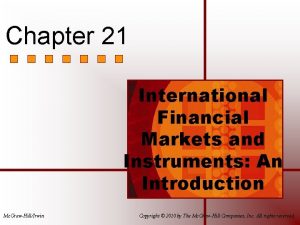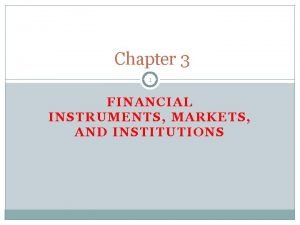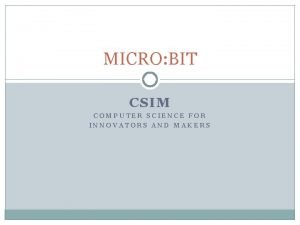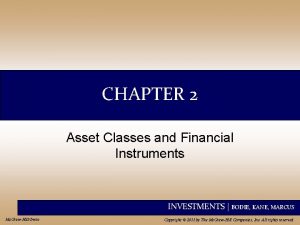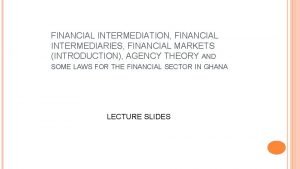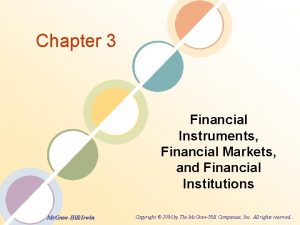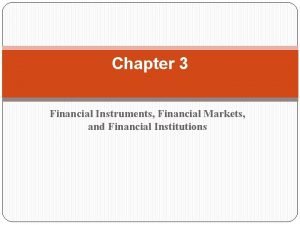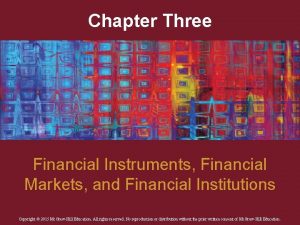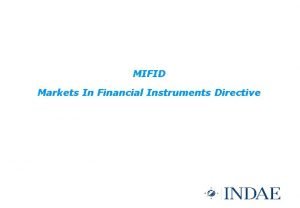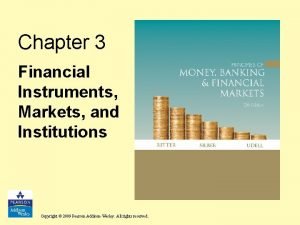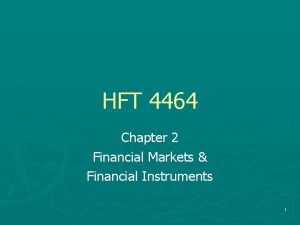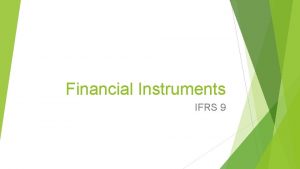CHAPTER Financial Markets Instruments and Market Makers Copyright








- Slides: 8

CHAPTER Financial Markets, Instruments, and Market Makers Copyright © 2003 by South-Western/Thomson Learning. All rights reserved. 6

The Principal Money Market Instruments: Amount Outstanding, End of Year (in Billions of Dollars) Type of Instrument 1960 1970 1980 1998 2001 c Treasury bills $37 $76 $200 $482 $ 691 $ 620 Negotiable CDs 0 45 260 NAa Commercial paperb 5 35 99 558 1, 173 1, 471 Bankers’ acceptances 1 4 32 52 14 7 Repurchase agreements and fed funds 1 22 102 324 878 1, 241 Eurodollars 1 20 68 NAa 151 214 a. Not available. b. Includes c. As commercial paper issued by financial and nonfinancial firms. of June 30, 2001. SOURCE: Federal Reserve Flow of Funds Accounts, Z 1, 2 nd Quarter 2001 (September 18, 2001). Copyright © 2003 by South-Western/Thomson Learning. All rights reserved. NAa

The Money Market Instrument Typical Maturities Principal Borrowers Secondary Market Treasury bills 3 to 12 months U. S. government Very active Negotiable CDs 1 to 6 months Depository institutions Modest activity Commercial paper 1 to 270 days Financial and business firms Moderately active Bankers’ acceptances 90 days Financial and business firms Limited Repurchase agreements 1 day, and 2 days to 3 months typical; 6 months less typical Banks, securities dealers, other owners of securities, nonfinancial firms, governments None, but very active primary market for short maturities Fed funds Chiefly 1 business day Depository institutions Active brokers’ market Eurodollars Overnight, 1 week, 1 to 6 months, and longer Banks None Copyright © 2003 by South-Western/Thomson Learning. All rights reserved.

Bankers’ Acceptances Goods Now IMPORTER EXPORTER Cash Later Goods Now IMPORTER w ts No EXPORTER men e m d Ti e t p e Acc aft Now Dr ater SOURCE: Adapted from Ann-Marie Meulendyke, U. S. Monetary Policy and Financial Markets (New York: Federal Reserve Bank of New York, 1989): 80 Copyright © 2003 by South-Western/Thomson Learning. All rights reserved. BANK Cash Late r INVESTOR Cash Now Cash L Accepted Now Transaction occurs with a bankers’ acceptance; less risk to the exporter Docu

The Principal Capital Market Instruments: Amount Outstanding, End of Year (in Billions of Dollars) Type of Instrument 1960 1970 1980 1998 Corporate stock $451 $906 $1, 920 $3, 530 $15, 438 $15, 863. 6 142 297 965 3, 804 5, 782 7, 250. 4 75 167 319 1, 704 3, 894 5, 435. 1 178 156 394 2, 776 3, 724 3, 234. 4 U. S. government agency securities* 10 51 170 426 1, 328 4, 620. 4 Municipal securities 71 144 NA 1, 464 1, 629. 3 Mortgages Corporate and foreign bonds U. S. government securities NA 2001** *Excludes federally sponsored mortgage pools. **As of June 30, 2001. SOURCE: Federal Reserve Flow of Funds Accounts, Z 1 (September 18, 2001); Federal Reserve Bulletin, various issues; Banking and Monetary Statistics 1941 -1970. Copyright © 2003 by South-Western/Thomson Learning. All rights reserved.

The Capital Market Instrument Typical Maturities Principal Borrowers Secondary Market Corporate Stock — Corporations Very active for large corporations Mortgages 15 to 30 years Home owners and other investors Moderately active Corporate bonds 2 to 30 years Corporations Active U. S. government securities Notes Bonds 2 to 10 years 30 years (currently) U. S. government Very active U. S. government agency securities Up to 30 years Municipals 2 to 30 years Very active U. S. government agency State and local governments Copyright © 2003 by South-Western/Thomson Learning. All rights reserved. Some activity Active

Market Makers Assist in raising funds to finance deficits by marketing a borrower’s new securities in the primary market MARKET MAKERS Advise potential buyers and sellers of securities on the course of action likely to minimize costs and maximize returns Copyright © 2003 by South-Western/Thomson Learning. All rights reserved. Stand ready to buy or sell outstanding securities in the secondary market

The Marketing and Subsequent Trading of a Corporate Bond APEI wants to issue bonds to finance investment Merrill Lynch agrees (for a fee) to design a bond offering and to market (sell) the bonds Primary Market Activity SSUs and financial intermediaries buy APEI bonds that will mature in 20 years One year later SSUs (or financial intermediaries) decide to sell some of their APEI bonds Salomon Smith Barney makes a market in APEI bonds by buying bonds from SSUs Salomon sells “used” APEI bonds to another SSU Copyright © 2003 by South-Western/Thomson Learning. All rights reserved. Secondary Market Activity
 International financial markets and instruments
International financial markets and instruments Basic flow of funds through the financial system
Basic flow of funds through the financial system Why study financial markets and institutions chapter 1
Why study financial markets and institutions chapter 1 -h#ps://microbit.org/fr/
-h#ps://microbit.org/fr/ Chapter 2 asset classes and financial instruments
Chapter 2 asset classes and financial instruments Segmentation targeting and positioning
Segmentation targeting and positioning Financial intermediation ppt
Financial intermediation ppt Financial markets and institutions ppt
Financial markets and institutions ppt Financial intermediary
Financial intermediary
